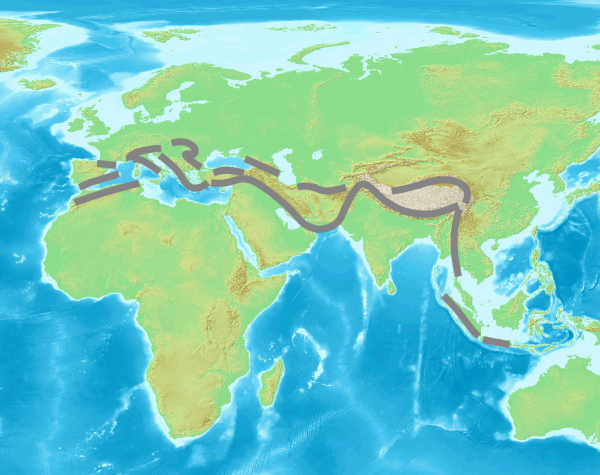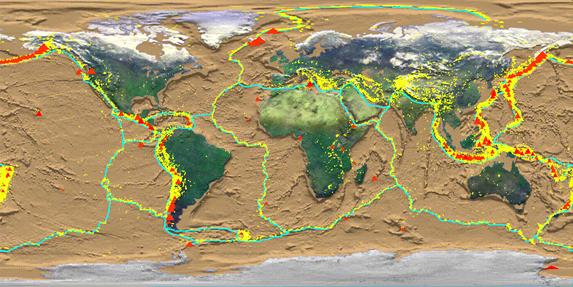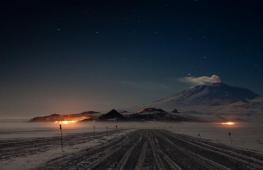Seismic belts of the earth
On Earth, there are special zones of increased seismic activity, where earthquakes constantly occur. Why is this happening? Why do earthquakes occur more often in mountainous areas and very rarely in deserts? Why are earthquakes constantly occurring in the Pacific Ocean, giving rise to tsunamis of varying degrees of danger, but we have heard almost nothing about earthquakes in the Arctic Ocean. It's all about the seismic belts of the earth.
Introduction
The seismic belts of the earth are the places where the lithospheric plates of the planet come into contact with each other. In these zones, where the seismic belts of the Earth are formed, there is an increased mobility of the earth's crust, volcanic activity due to the process of mountain building, which lasts for millennia.
The length of these belts is incredibly large - the belts stretch for thousands of kilometers.
There are two large seismic belts on the planet: the Mediterranean-Trans-Asian and the Pacific.

Rice. 1. Seismic belts of the Earth.
Mediterranean-Trans-Asian the belt originates off the coast of the Persian Gulf and ends in the middle of the Atlantic Ocean. This belt is also called the latitudinal belt, as it stretches parallel to the equator.
pacific belt- meridional, it stretches perpendicular to the Mediterranean-Trans-Asian belt. It is on the line of this belt that a huge number of active volcanoes are located, most of the eruptions of which occur under the water column of the Pacific Ocean itself.
If you draw the seismic belts of the Earth on a contour map, you will get an interesting and mysterious drawing. The belts seem to border the ancient platforms of the Earth, and sometimes they are embedded in them. They are associated with giant faults in the earth's crust, both ancient and younger.
Mediterranean-Trans-Asian seismic belt
The latitudinal seismic belt of the Earth passes through the Mediterranean Sea and all the European mountain ranges adjacent to it, located in the south of the continent. It stretches through the mountains of Asia Minor and North Africa, reaches the mountain ranges of the Caucasus and Iran, runs through all of Central Asia and the Hindu Kush right to Koel-Lun and the Himalayas.
In this belt, the most active seismic zones are the Carpathian Mountains located on the territory of Romania, all of Iran and Balochistan. From Balochistan, the earthquake zone extends to Burma.

Fig.2. Mediterranean-Trans-Asian seismic belt
This belt has active seismic zones, which are located not only on land, but also in the waters of two oceans: the Atlantic and Indian. Partially, this belt captures the Arctic Ocean. The seismic zone of the entire Atlantic passes through the Greenland Sea and Spain.
The most active seismic zone of the latitudinal belt falls on the bottom of the Indian Ocean, passes through the Arabian Peninsula and stretches to the very south and southwest of Antarctica.
pacific belt
But, no matter how dangerous the latitudinal seismic belt is, nevertheless, most of all earthquakes (about 80%) that occur on our planet occur in the Pacific belt of seismic activity. This belt runs along the bottom of the Pacific Ocean, along all the mountain ranges that encircle this largest ocean on Earth, captures the islands located in it, including Indonesia.

Fig.3. Pacific seismic belt.
The largest part of this belt is the Eastern. It originates in Kamchatka, stretches through the Aleutian Islands and the western coastal zones of North and South America straight to the South Antilles loop.
The eastern branch is unpredictable and poorly understood. It is full of sharp and twisty turns.
The northern part of the belt is the most seismically active, which is constantly felt by the inhabitants of California, as well as Central and South America.
The western part of the meridional belt originates in Kamchatka, stretches to Japan and beyond.
Secondary seismic belts
It is no secret that during earthquakes, waves from vibrations of the earth's crust can reach remote areas that are considered safe in relation to seismic activity. In some places, the echoes of earthquakes are not felt at all, and in some they reach several points on the Richter scale.

Fig.4. Earth seismic activity map.
Basically, these zones, sensitive to fluctuations of the earth's crust, are located under the water column of the oceans. The secondary seismic belts of the planet are located in the waters of the Atlantic, Pacific Ocean, Indian Ocean and in the Arctic. Most of the secondary belts fall on the eastern part of the planet, so these belts stretch from the Philippines, gradually descending to Antarctica. Echoes of shocks can still be felt in the Pacific Ocean, but in the Atlantic it is almost always a seismically calm zone.
What have we learned?
So, on Earth, earthquakes do not occur in random places. It is possible to predict the seismic activity of the earth's crust, since the main part of earthquakes occurs in special zones, which are called the seismic belts of the earth. There are only two of them on our planet: the latitudinal Mediterranean-Trans-Asian seismic belt, which stretches parallel to the Equator, and the meridional Pacific seismic belt, located perpendicular to the latitudinal one.


